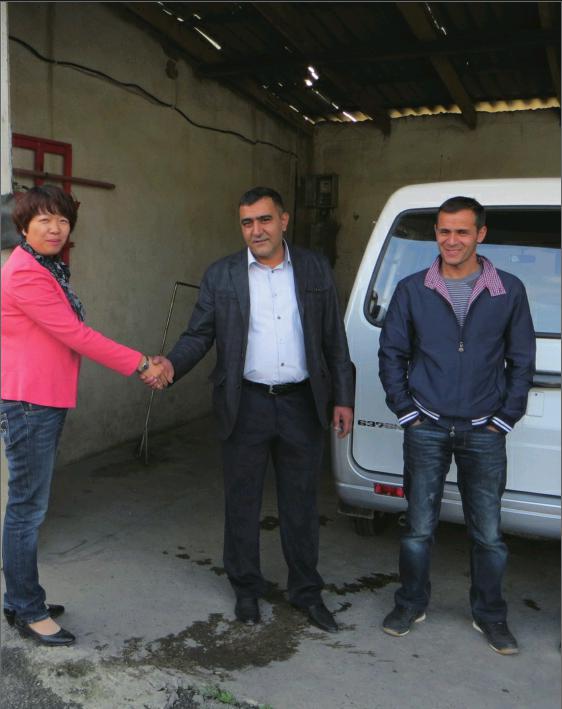On the Road
2017-06-22ByJiangWandi
By+Jiang+Wandi

The winter of early 2017 in Tajikistan was unusually cold, and so was the Central Asian countrys economic climate. The governments financial situation was strained, and many projects scheduled for launch had to be shelved because of a lack of funds. A World Bank report showed that in 2016, Tajikistans GDP growth rate was 4 percent. Continuing economic sanctions imposed by the West have led to Russias economic downturn, and as a result, a large number of Tajikistanis working in Russia have had to return home, resulting in the remittance income that Tajikistan highly depends on plummeting. Weak exports in recent years have also been an important factor adversely affecting Tajikistans economy.
Despite the harsh economic situation, Chinese companies in Tajikistan continue their operation without respite. So far, in addition to the 67 Chinese state-owned firms that are constructing railways and roads and building plants and residential buildings in Tajikistan, more than 450 private Chinese fi rms are investing and operating in the country, according to official statistics. Undaunted by hardship, they strive to adapt to the local natural and policy environments, creating jobs for Tajikistani people and invigorating the economy.
Cheng Rong, a young businesswoman from northwest Chinas Xinjiang Uygur Autonomous Region, is no exception.
Cheng came to Tajikistan in 2010. Having been educated in pharmacology and the Russian language, she had a stable job and comfortable life in China. But, she wanted to try a different lifestyle.
Breaking new ground
In Tajikistan, Cheng started with selling China-made engineering machinery to local companies, including cranes, concretemixing equipment, excavators and loaders.
“Chinese machinery is the most popular with customers among foreign brands in Tajikistan,” Cheng said. “They are priced much lower than similar European products, and there are more varieties for consumers to choose from. Chinese products can be tailor-made, and the prices of spare parts are very cheap too.”
Moreover, imports from China can be delivered fast because of the geographical proximity, and urgently needed parts shipped by air can arrive within 24 hours. “So Tajikistani consumers prefer buying Chinese engineering machinery,” she said.
In addition to engineering machinery, Cheng also sells vehicles, such as dump trucks, fi re engines, police cars, ambulances, buses and pickup trucks. She oversees a representative office of the Nanjing Automobile Import and Export Co. Ltd. in Tajikistan, promoting vehicles produced in China not only in the country but also to neighboring Afghanistan and other Central Asian nations.
Tajikistans urban public transit system is underdeveloped, and the country has few modern buses. Buses produced in China are cheap and of good quality, so they are very popular among Tajikistanis. Many such imported buses have been painted with the words “Bus of Friendship” and so have become an eye-catching aspect of local urban environments.
However, poor railway and highway transportation in Tajikistan has been a bottleneck hampering the import of vehicles. Sometimes, poor road conditions were exacerbated by security threats. Cheng remembered an adventure she experienced in August 2012, when she led 12 Tajikistani drivers to pick up 12 new cars from Karasu Port of China and then drive them all the way to Dushanbe, Tajikistans capital. The two-way journey covered 2,200 km, of which only 300 km was urban road, while the rest was dirt road in the mountains. Some stretches of the road were dangerous, especially the section crossing the Pamirs Plateau, which lies 4,000 meters above sea level.
On their way back from the Chinese bor- der port, some 35 km away from Khorugh City, they learned that a small-scale armed riot had broken out in the city. Although very frightened, Cheng led the team to hide in a small village 18 km outside the city. The villagers let them shelter in a primary school for a week until government forces quelled the riot.
In 2013, Cheng set up a new company—Sharaftekhnoplys—whose main business is shipping materials such as cement and sandstone for large engineering projects.
Tajikistan is a mountainous country, with two thirds of its land lying 3,000 meters or more above sea level. Its mountain roads have been so poorly maintained that drivers who are not familiar with local conditions dare not take them. Cheng hires experienced local drivers to work for her company. Its fi rst-class vehicles and service have made the company a welcome partner to both Chinese construction fi rms in Tajikistan and local fi rms. Currently, it is working on a Chinafunded large agricultural project.
Offering consulting services
Now Cheng has worked and lived in Tajikistan for seven years, and she has overcome numerous difficulties and knows the country much better.
Due to an electricity shortage, most people in Tajikistan spent the winter without heating. Cheng tried to keep her offi ce warm with a small electric heater, but it had limited effect. She answered phone calls and input orders with frostbitten hands.
She is fluent in both Tajiki and Russian, which are important tools for her to travel around the country making friends and conducting business.
She began to learn Tajiki soon after she arrived in Tajikistan. Although Cheng could speak Russian, in the 20-plus years since Tajikistan gained independence from the former Soviet Union in 1991, the importance of Russian has gradually faded in many fields, and Tajiki has become the countrys offi cial language. Cheng learned Tajiki by watching local TV programs every day.
In recent years, more and more Chinese enterprises have arrived in Tajikistan to explore investment and business opportunities, especially after Chinese President Xi Jinping proposed the Belt and Road Initiative in 2013.
“If you come to this country and look and study carefully, you will fi nd that Tajikistan is rife with opportunities. Tajikistans economy is still underdeveloped, so a lot of things wait to be done,” Cheng said.
Nonetheless, as the countrys land area is not vast, its population not large, and its demand relatively not high, its opportunities are suitable for small and medium-sized enterprises, she added.
But many Chinese business people returned to China not long after they ventured into Tajikistan because they were not accustomed to the local business and living environments. Although Tajikistan and China are friendly neighbors, and China has a Tajik ethnic group, the national conditions, economic development levels and policies of the two countries differ signifi cantly.
Having learned this, Cheng decided to launch a new business providing consulting service for Chinese companies new to Tajikistan and helping them handle various formalities. In this way, Cheng shares her knowledge and experience in Tajikistan and assists Chinese businesses to take a solid fi rst step in the country.
As Chengs business grows, she has attended more and more business events. Serving as a bridge between Chinese and Tajikistan business people, she regularly shuttles between Tajikistan and her hometown Urumqi in Xinjiang. As for the future, Cheng plans to expand her business to other Central Asian countries.
